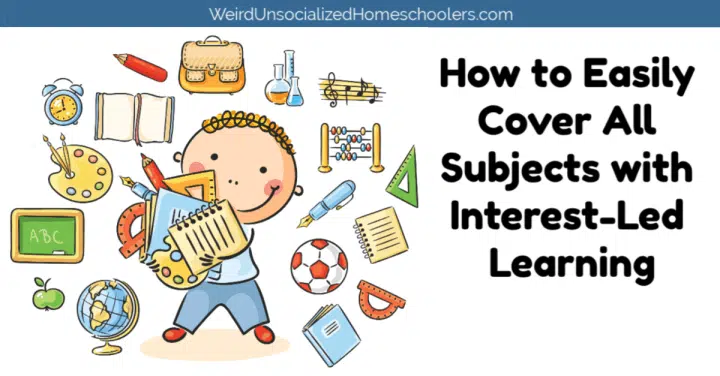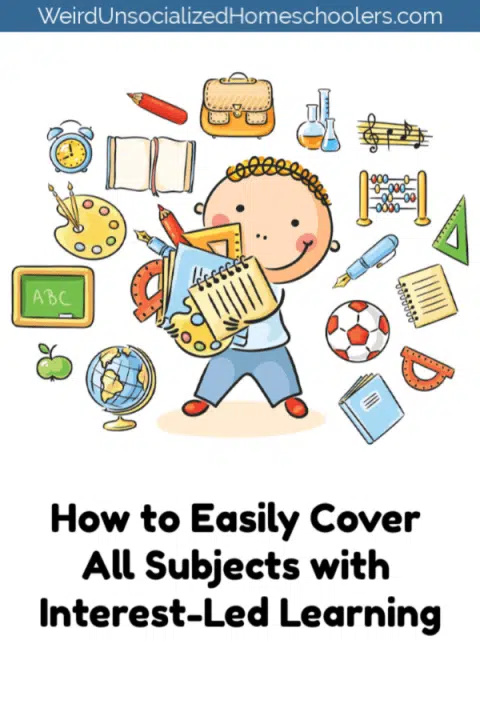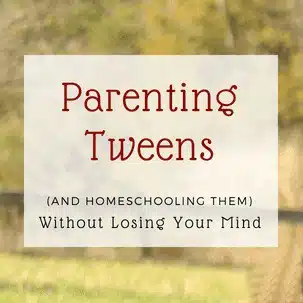How to Easily Cover All Subjects with Interest-Led Learning
Discover how easy it is for children to learn what they need to know in all subject areas while following an interest-led learning approach.
Can children really learn all they need to learn by following their interests? Covering all subjects is indeed possible whether you follow an interest-led learning approach all the time, part-time, only in spring and summer, or just in the afternoon.
You can integrate your children’s passions into your homeschool rhythm if you are willing to support and nurture their growing interests. But sometimes you have to think outside the box.

Interest-Led Learning
To make the most of interest-led learning, look for ways to support your children’s interests. For example, one of my son’s interests is the guitar, so I look for ways to nurture that.
He has been taking guitar lessons for several years with Gentle Guitar. His goal when he started was to learn to play Beethoven’s 5th. Now he’s researching the greatest guitarists of all time like B.B. King, Jimi Hendrix, and Keith Richards by looking up their most notable songs on YouTube and comparing different techniques.
He is also learning to play by ear the theme songs from his favorite video games and considering the MasterClass, Carlos Santana Teaches the Art and Soul of Guitar.

I recently discovered that the local music store has artists come and play on Saturdays. My son is excited to meet others with a passion for music. He has even performed for folks at the local retirement home.
We’ll see where this interest leads him. Perhaps he’ll be inspired for years to come. Maybe this obsession will end in a few days or weeks. But I’ll support his interests for however long they interest him.
How to Start Following Those Rabbit Trails of Learning
It’s easy to feel overwhelmed or worry that our kids aren’t covering the subjects they need to include when following their interests. Sometimes I get in my own way because the children may not be interested in what I think they should be interested in.
We do follow a slightly more disciplined approach for some subjects like math. But it’s typically more structured in the fall and winter. Spring and summer tend to be more unschooly.
After all, education isn’t about the memorization of facts. For us, it’s about learning HOW to learn.
But, let me assure you, children learn far more when they are interested.

You may be wondering how covering all subjects can happen when you are following your child’s interests. The key is to create a learning-rich environment and be willing to follow the rabbit trails.
This is how I get started:
- Strewing. I strew loads of interesting things around our home to see what sparks interest. Strewing is the act of leaving out items or resources of interest for your children to interact and engage with. I also observe what my kiddos choose at the library to help me hone in on their interests.
- Modeling. I model curiosity for my children by showing interest in some of the items I strew or merely being curious about the world around me — kids model what they see. I don’t pretend to have all the answers, but I am willing to look up the answers alongside my children.
- Expanding. Once I find something that sticks with my kiddos, I look for other things we can do with it. Is there a way to incorporate documentaries or films about the subject? What about board games or card games? Are there books to help us dive deeper? I start to think outside the box.

Helping Kids Explore Their Passions
You may be shocked to see how those rabbit trails of learning take off. Last month we started studying India, not because I planned it, but because of a book on Indian Folktales the kids picked up from the library.
This book led to documentaries on India. We snagged more books on Indian culture, peacocks, Bengal tigers, and elephants. We watched documentaries on the wildlife in India.
My children’s interests grew. They learned about endangered species, ecosystems, and conservation efforts in India and across the world. They are now saving up their allowances to donate to the World Wildlife Fund.
Then we stumbled upon famous structures in India including the Taj Mahal and the Mehrangarh Fort which my son started building in Minecraft.
The Who Was Books helped us learn more about Mother Theresa and Gandhi.
We tried different Indian cuisines. The kids’ favorite was the Tikka Masala.
My son started reading The Jungle Book by Rudyard Kipling which led us to Rudyard Kipling’s book of poetry for our poetry teatime. Then we binged watched the different versions of The Jungle Book films!

We played chess while talking about the different games which originated in ancient India. Did you know that the decimal system in use today was first recorded in India?
Now, my son is learning Hindi with Duolingo.
This is a “rabbit trail” of learning! No pressure to learn anything, but a more organic and satisfying learning experience. It’s a process for both myself and the kiddos as we ask questions, explore, and dive deep.
Covering All Subjects
Every child is different, and you know your kiddo better than anyone. You also know what sort of learning environment your child learns best in.
I start by creating a little road map in my planning notebook to help me see all the ways we can incorporate the subject of interest and how all learning is connected. Then I look for resources to help me help my kids. You really can include all subjects! Many of these subjects can and will overlap.
- Math – Include math with games, STEM challenges, budgeting, manipulatives, puzzles, woodworking, garden planning, sewing, math books, documentaries, cooking from recipes, and menu planning.
- Reading/Writing/Language Arts – Read books about your child’s preferred subject, watch documentaries and films, and journal about the subject. Let your kids perform their own skit or write their own play! There is also copywork and dictation that you can take from the books of interest. Try learning a foreign language or playing language games!
- Art – Incorporate art by learning music, creating artwork, playing games, or reading books about art and artists.
- Nature – Explore with documentaries, nature walks, zoos, farms, pets, bird feeders, games, field guides, and other books.
- History – Visit museums, culture, and heritage sites. Watch documentaries, play games, and read books.
- Science – Try ideas like 4H or robotics club, science fairs, games, experiments, raising tadpoles and butterflies, or watching science documentaries.
Making observations and asking questions about anything and everything will go a long way in understanding how things work.

What Happens When Your Child Loses Interest?
What happens when the children are no longer interested?
We move on.
It can prove frustrating when today the children are interested in dinosaurs, but in three days’ time, their interests turn to sharks. But I’ve learned to let go of the things that don’t work for my kids and their education.
The thing is that I support my children’s interests for as long as they are interested. That may be for a few days, weeks, or months. But we are covering all subjects and growing our love of learning with this interest-led education.
What are some rabbit trail topics that have inspired organic learning in your homeschool?
You Might Also Like
Erin Vincent is a homeschooling mom to two intense kids. They are child led with a heavy emphasis on read alouds, games, art, nature hikes, and hands on science! They traded the hustle and bustle of city life for the quiet farm life where opportunities for exploration in nature abound. When they're not homeschooling you'll find Erin curled up with a cup of coffee and a good book!. You can find Erin at Nourishing My Scholar.






